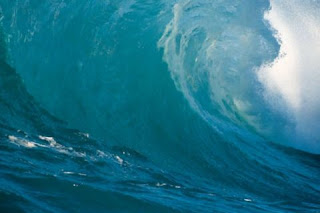A red line separates possible disaster from safety—the line past which you would have to run to be safe from an inundation. The map will help authorities plan emergency response plans, showing which areas may need to be evacuated. It covers the 50 percent of the California coastline that is significantly populated, and is "based on the largest anticipated tsunami event, plus a high tide," said State Geologist John Parrish of the California Geological Survey in a press conference at a meeting here of the American Geophysical Union.
Scientists preparing the map used computer simulations to model the tsunamis that happen once every 500 to 1,000 years—including those caused by remote earthquakes or underwater slides that could affect the California coast. The scientists heeded the lessons of the 2004 event, which showed how waves can still have deadly impacts after traveling thousands of miles. "Post-Sumatra, we started considering events that are all along the Pacific Ocean," said Costas Synolakis, director of the University of Southern California's Tsunami Research Center.
Although San Francisco is often seen as the earthquake capital of the U.S., the most destructive tsunamis would probably not originate here nor anywhere in the states. Large tsunamis are typically produced by tectonic plates moving vertically, whereas California mostly has plates moving sideways past other, as happens along the San Andreas Fault. Instead, scientists are especially concerned by waves that could originate in the Cascadia subduction zone, which extends from British Columbia to Oregon, or even farther north in the Aleutian Islands.
Waves from a large event, such as a high-magnitude Cascadian earthquake, could affect up to 350,000 people along the California coast—not including the people who may be visiting the state's beaches on a warm summer day, explains Rick Wilson of the California Geological Survey. Waves could typically reach 45 feet at Crescent City, in the northernmost part of the state, and 10 to 12 feet in Southern California, Wilson says.
But because tsunami waves can be greatly amplified or dampened by the local profile of the seafloor and by the shape of the coastline, the effects could vary greatly. In particular, a counterintuitive conclusion of the study is that in crescent-shaped bays, the south-facing northern coast could be hit by worse waves than the north-facing south coast, even though the waves would come from the north. For example, in Monterey Bay, Santa Cruz may be more affected than Monterey, Wilson says.
And of course, low-lying coastal areas will take the worst hits even from relatively low waves, points out Aggeliki Barberopoulou of the University of Southern California, who carried out the computer simulations. For instance, whereas in hilly San Francisco waves might move inland by just a couple of city blocks, in places such as Newport Beach (in Orange County) the inundation may reach a mile or more farther, making evacuation more difficult.
Source:
www.scientificamerican.com

No comments:
Post a Comment